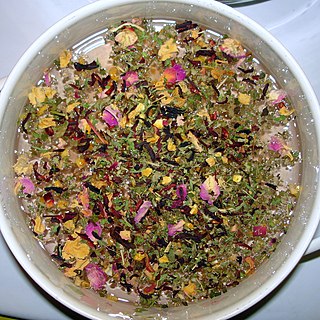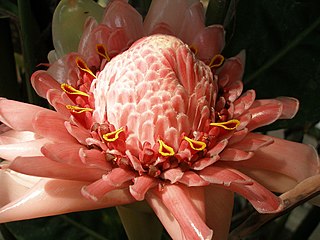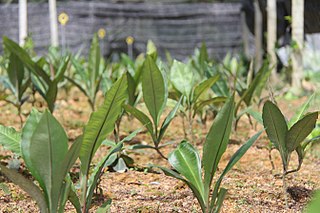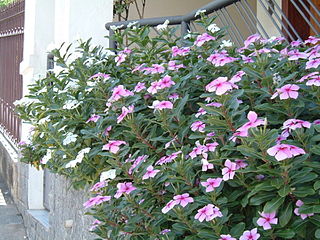
Herbal teas, also known as herbal infusions and less commonly called tisanes, are beverages made from the infusion or decoction of herbs, spices, or other plant material in hot water; they do not usually contain any true tea. Often herb tea, or the plain term tea, is used as a reference to all sorts of herbal teas. Many herbs used in teas/tisanes are also used in herbal medicine and in folk medicine. Some herbal blends contain true tea.

Malaysian cuisine consists of cooking traditions and practices found in Malaysia, and reflects the multi-ethnic makeup of its population. The vast majority of Malaysia's population can roughly be divided among three major ethnic groups: Malays, Chinese and Indians. The remainder consists of the indigenous peoples of Sabah and Sarawak in East Malaysia, the Orang Asli of Peninsular Malaysia, the Peranakan and Eurasian creole communities, as well as a significant number of foreign workers and expatriates.

Ginseng is the root of plants in the genus Panax, such as Korean ginseng (P. ginseng), South China ginseng (P. notoginseng), and American ginseng (P. quinquefolius), characterized by the presence of ginsenosides and gintonin. Ginseng is common in the cuisines and medicines of China and Korea.

Malay cuisine is the traditional food of the ethnic Malays of Southeast Asia, residing in modern-day Malaysia, Indonesia, Singapore, Brunei, Southern Thailand and the Philippines as well as Cocos Islands, Christmas Island, Sri Lanka and South Africa.

Betel nut chewing, also called betel quid chewing or areca nut chewing, is a practice in which areca nuts are chewed together with slaked lime and betel leaves for their stimulant and narcotic effects, the primary psychoactive compound being arecoline. The practice is widespread in Southeast Asia, Micronesia, Island Melanesia, and South Asia. It is also found among both Han Chinese immigrants and indigenous peoples of Taiwan, Madagascar, and parts of southern China. It was introduced to the Caribbean in colonial times.
In early ayurvedic medicine, rasāyana is one of the eight areas of medicine in Sanskrit literature.

Eurycoma longifolia is a flowering plant in the family Simaroubaceae. It is native to Indochina and Indonesia, but has also been found in the Philippines. The plant is a medium-sized slender shrub that can reach 10 m (33 ft) in height, and is often unbranched. The root of the plant has been used in folk medicine of the South East Asian region, and in modern times has common use as supplements, as well as food and drink additives.

Tea blending is the act of blending different teas to produce a final product that differs in flavor from the original tea used. This occurs chiefly with black tea, which is blended to make most tea bags, but it can also occur with such teas as Pu-erh, where leaves are blended from different regions before being compressed. The most prominent type of tea blending is commercial tea blending, which is used to ensure consistency of a batch on a mass scale so that any variations between different batches and seasons of tea production do not affect the final product. Commercially, it is considered important that any batch of a particular blend must taste the same as the previous batch, so a consumer will not be able to detect a difference in flavor from one purchase to the next.

Peranakan cuisine or Nyonya cuisine comes from the Peranakans, descendants of early Chinese migrants who settled in Penang, Malacca, Singapore and Indonesia, inter-marrying with local Malays. In Baba Malay, a female Peranakan is known as a nonya, and a male Peranakan is known as a baba. The cuisine combines Chinese, Malay, Javanese, South Indian, and other influences.

Etlingera elatior is a species of herbaceous perennial plant in the family Zingiberaceae; it is native to Indonesia, Thailand, Malaysia and New Guinea.

Jamu is a traditional medicine from Indonesia. It is predominantly a herbal medicine made from natural materials, such as roots, bark, flowers, seeds, leaves and fruits. Materials acquired from animals, such as honey, royal jelly, milk and native chicken eggs are often used as well.

Labisia pumila is a flowering plant in the family Primulaceae native to Malaysia. It is a small, woody and leafy plant with leaves of 20 cm (7.9 in) in length, and grows widely in the shade of the tropical forest floor. The plant is popular in the traditional medicine of the Malaysian and Indonesian community, in which it is believed to be the female version of the equally well-known tongkat Ali, i.e. Ali's walking stick.
Yorùbá medicine, or egbòogi, is a Yoruba system of herbalism practiced primarily in West Africa and the Caribbean.

Cosmos caudatus or king's salad is an annual plant in the genus Cosmos, bearing purple, pink, or white ray florets. It is native to Latin America, and the West Indies, though naturalized in tropical parts of Asia, Africa, and Australia.

Garcinia atroviridis, known as asam gelugur, asam gelugo, or asam keping is a large rainforest tree native to Peninsular Malaysia and Sumatra. This species grows wild throughout Peninsular Malaysia but is also widely cultivated, especially in the northern states, owing to its economic and medicinal value. Garcinia atroviridis is a large perennial plant commonly found in evergreen forests in the southern region of Thailand and Malaysia.

In general use, herbs are a widely distributed and widespread group of plants, excluding vegetables and other plants consumed for macronutrients, with savory or aromatic properties that are used for flavoring and garnishing food, for medicinal purposes, or for fragrances. Culinary use typically distinguishes herbs from spices. Herbs generally refers to the leafy green or flowering parts of a plant, while spices are usually dried and produced from other parts of the plant, including seeds, bark, roots and fruits.

Brazilian tea culture has its origins in the infused beverages, or chás, made by the indigenous cultures of the Amazon and the Río de la Plata basins. It has evolved since the Portuguese colonial period to include imported varieties and tea-drinking customs.

Dominican tea culture combines many customs adapted from various colonial and immigrant cultures that have mingled in Dominica. "Bush teas", made from local herbal plants and often taken for medicinal purposes, are a traditional part of Dominica's culture.

Simpang Durian is a small town in Jelebu District, Negeri Sembilan, Malaysia. It is situated about 10 km from the Pahang border and about 130 km from Kuala Lumpur. Simpang Durian is also a popular stopover destination for super bikers from Singapore and southern states of West Malaysia to rest and refuel before proceeding to Genting Highlands.

Sarawakian cuisine is a regional cuisine of Malaysia. Similar to the rest of Malaysian cuisine, Sarawak food is based on staples such as rice. There is also a great variety of other ingredients and food preparations due to the influence of the state's varied geography and indigenous cultures quite distinct from the regional cuisines of the Peninsular Malaysia. Sarawak is famous for its multi-ethnic population. As the homeland of many unique communities, Sarawak has a variety of cuisines rarely found elsewhere in Malaysia. The uniqueness of Sarawak well depends on its ethnic groups. Every native group in Sarawak has their own lifestyle, traditions, cultures and also foods. Sarawak cuisine is less spicy and has a subtle in taste. It uses fresh seafood and natural herbs like turmeric, lemongrass, ginger, lime and tapioca leaves. These ingredients are not only easily available, but also add a hint of aroma, texture and freshness to the delicacies. Food is one of the most cultural identities for native groups in Sarawak with each ethnic group having their own delicacies. Among the Iban, popular foods include tubu (stems), tuak and pansuh. The Malay have bubur pedas (porridge) and kek lapis Sarawak ; the Bidayuh have asam siok and sup ponas Bidayuh. The Melanau make tebaloi, sagu and umai and the Orang Ulu are known for garam barrio, kikid (broth), tengayen, and urum giruq (pudding).

















